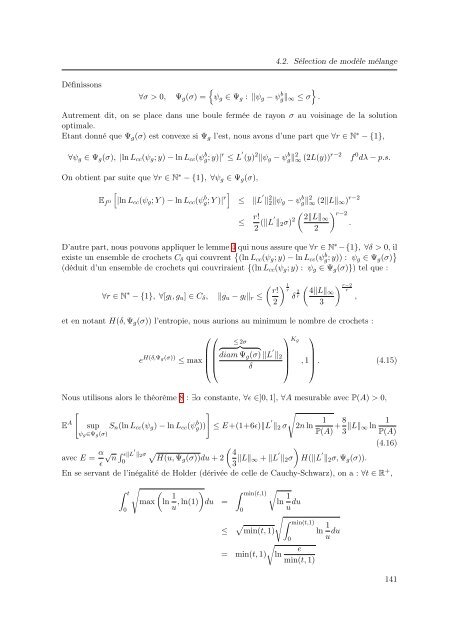Mélanges de GLMs et nombre de composantes : application ... - Scor
Mélanges de GLMs et nombre de composantes : application ... - Scor
Mélanges de GLMs et nombre de composantes : application ... - Scor
You also want an ePaper? Increase the reach of your titles
YUMPU automatically turns print PDFs into web optimized ePapers that Google loves.
4.2. Sélection <strong>de</strong> modèle mélange<br />
Définissons<br />
∀σ > 0, Ψ g (σ) =<br />
{<br />
}<br />
ψ g ∈ Ψ g : ‖ψ g − ψg‖ b ∞ ≤ σ .<br />
Autrement dit, on se place dans une boule fermée <strong>de</strong> rayon σ au voisinage <strong>de</strong> la solution<br />
optimale.<br />
Etant donné que Ψ g (σ) est convexe si Ψ g l’est, nous avons d’une part que ∀r ∈ N ∗ − {1},<br />
∀ψ g ∈ Ψ g (σ), |ln L cc (ψ g ; y) − ln L cc (ψ b g; y)| r ≤ L ′ (y) 2 ‖ψ g − ψ b g‖ 2 ∞ (2L(y)) r−2<br />
f 0 dλ − p.s.<br />
On obtient par suite que ∀r ∈ N ∗ − {1}, ∀ψ g ∈ Ψ g (σ),<br />
E f 0<br />
[<br />
|ln L cc (ψ g ; Y ) − ln L cc (ψ b g; Y )| r] ≤ ‖L ′ ‖ 2 2‖ψ g − ψ b g‖ 2 ∞ (2‖L‖ ∞ ) r−2<br />
≤ r! ( ) r−2<br />
2 (‖L′ ‖ 2 σ) 2 2‖L‖∞<br />
.<br />
2<br />
D’autre part, nous pouvons appliquer le lemme 4 qui nous assure que ∀r ∈ N ∗ −{1}, ∀δ > 0, il<br />
existe un ensemble <strong>de</strong> croch<strong>et</strong>s C δ qui couvrent { (ln L cc (ψ g ; y) − ln L cc (ψ b g; y)) : ψ g ∈ Ψ g (σ) }<br />
(déduit d’un ensemble <strong>de</strong> croch<strong>et</strong>s qui couvriraient {(ln L cc (ψ g ; y) : ψ g ∈ Ψ g (σ)}) tel que :<br />
∀r ∈ N ∗ − {1}, ∀[g l , g u ] ∈ C δ ,<br />
‖g u − g l ‖ r ≤<br />
( ) 1<br />
r! r 2<br />
δ r<br />
2<br />
( 4‖L‖∞<br />
3<br />
) r−2<br />
r<br />
,<br />
<strong>et</strong> en notant H(δ, Ψ g (σ)) l’entropie, nous aurions au minimum le <strong>nombre</strong> <strong>de</strong> croch<strong>et</strong>s :<br />
⎛⎛<br />
⎞<br />
≤ 2σ<br />
K g<br />
{ }} {<br />
e H(δ,Ψg(σ)) diam Ψ g (σ) ‖L ′ ‖ 2<br />
≤ max ⎜⎜<br />
⎟ , 1⎞<br />
⎟<br />
⎝⎝<br />
δ ⎠ ⎠ . (4.15)<br />
Nous utilisons alors le théorème 8 : ∃α constante, ∀ɛ ∈]0, 1], ∀A mesurable avec P(A) > 0,<br />
[<br />
]<br />
√<br />
E A sup S n (ln L cc (ψ g ) − ln L cc (ψg))<br />
b ≤ E+(1+6ɛ)‖L ′ ‖ 2 σ 2n ln 1<br />
ψ g∈Ψ g(σ)<br />
P(A) + 8 3 ‖L‖ ∞ ln 1<br />
P(A)<br />
(4.16)<br />
avec E = α (<br />
√ ∫ ′ ɛ‖L ‖2 σ<br />
√ 4 n<br />
ɛ<br />
0 H(u, Ψg (σ))du + 2<br />
3 ‖L‖ ∞ + ‖L ′ ‖ 2 σ)<br />
H(‖L ′ ‖ 2 σ, Ψ g (σ)).<br />
En se servant <strong>de</strong> l’inégalité <strong>de</strong> Hol<strong>de</strong>r (dérivée <strong>de</strong> celle <strong>de</strong> Cauchy-Schwarz), on a : ∀t ∈ R + ,<br />
∫ t<br />
0<br />
√<br />
max<br />
(ln 1 u , ln(1) )<br />
du =<br />
∫ min(t,1)<br />
0<br />
√<br />
ln 1 u du<br />
√ ∫ min(t,1)<br />
≤ √ min(t, 1)<br />
√<br />
e<br />
= min(t, 1) ln<br />
min(t, 1)<br />
0<br />
ln 1 u du<br />
141
















